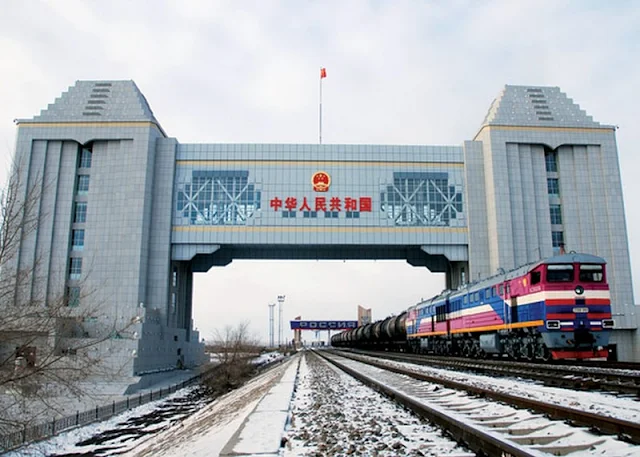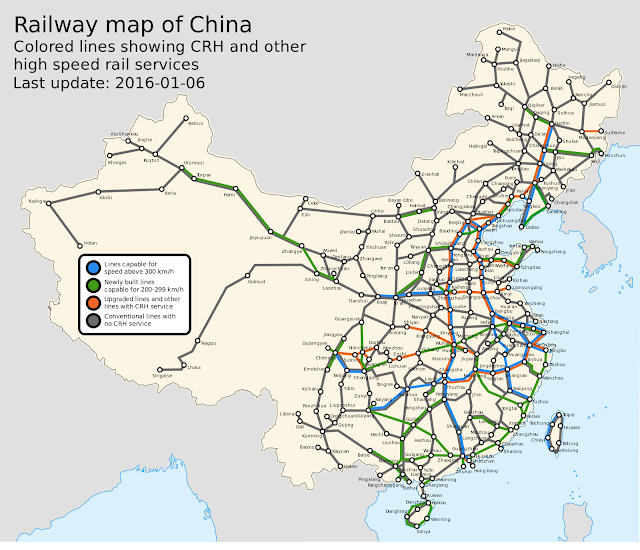The Chinese rail freight transportation system is operated by the Chinese government. The synergy of the rail freight transportation system dynamically combines all the subsystems together for cooperation and work to improve efficiency and effectiveness, in order to enhance its own strength.
By IndraStra Global Editorial Team
Image Attribute: Chinese Freight Train crossing an International Border / Creative Commons
Image Attribute: Chinese Freight Train crossing an International Border / Creative Commons
China is characterized by its large area and its high population, coupled with accelerated industrialization and urbanization. All of these factors lead to a vast exchange of materials and personnel across the country. The China's railway transportation under China Railway Corporation covers the transport of all key resources, including coal, steel, and food from the northern and western regions to the northern and southern areas of the country. Incidentally, many of China’s developed industrial areas badly need huge quantities of raw materials and energy, which has led to an increased demand for rail transport. These demands have put a tremendous strain on China’s currently limited railway infrastructure and capacity.

Find more statistics at Statista
From 1978 to 2005, development in infrastructure allowed for a mere 3.5% yearly average growth in railway freight volume, while freight volume in all modes of transport achieved an average annual growth of 8%. During this period, the railway system experienced a yearly average growth of 1% in passenger transport volume, while the volume in all modes of transport achieved a similar yearly average growth of 8%
Freight trains in China are primarily used to ship bulk cargo. The important cargo is coal, which accounts for more than half of total rail freight tonnage. In 2013, 2.322 billion tons of coal were shipped on trains in China, about 58% of the total rail freight tonnage of 3.967 billion. Another one-fifth of rail freight was devoted to ores and minerals, which were 851 million tons (21.5%) in 2013. Other major categories of bulk goods include grain (110 million tons, 2.77% in 2013) and fertilizer (87 million tons, 2.19% in 2013) Container cargo constitutes a small fraction of the total freight, about 88 million tons or 2.21% in 2013.
Nearly all rail freight in China is used for domestic shipping. International rail cargo totaled 58 million tons in 2013, about 1.46% of overall freight tonnage. The four largest rail ports of entry, Manzhouli, Suifenhe, Erenhot,Alashankou and accounted 56 million tons or 96.5% of the total.
Freight trains in China are primarily used to ship bulk cargo. The important cargo is coal, which accounts for more than half of total rail freight tonnage. In 2013, 2.322 billion tons of coal were shipped on trains in China, about 58% of the total rail freight tonnage of 3.967 billion. Another one-fifth of rail freight was devoted to ores and minerals, which were 851 million tons (21.5%) in 2013. Other major categories of bulk goods include grain (110 million tons, 2.77% in 2013) and fertilizer (87 million tons, 2.19% in 2013) Container cargo constitutes a small fraction of the total freight, about 88 million tons or 2.21% in 2013.
Nearly all rail freight in China is used for domestic shipping. International rail cargo totaled 58 million tons in 2013, about 1.46% of overall freight tonnage. The four largest rail ports of entry, Manzhouli, Suifenhe, Erenhot,Alashankou and accounted 56 million tons or 96.5% of the total.
Cities in the Chinese interior have opened international rail freight routes to promote trade. In 2011, Chongqing began freight service to Duisburg, Germany, via Kazakhstan, Russia, and Poland. The route shortened shipping time from five weeks by sea to about two weeks and costs 80% less than air cargo.
The Chinese rail freight transportation system is operated by the Chinese government. The synergy of the rail freight transportation system dynamically combines all the subsystems together for cooperation and work to improve efficiency and effectiveness, in order to enhance its own strength. Improving the synergy degree of every subsystem is a helpful way to improve the efficiency and capacity of the railway freight transportation.
Map Attribute: Railways Map of China
The Chinese rail freight transportation system is operated by the Chinese government. The synergy of the rail freight transportation system dynamically combines all the subsystems together for cooperation and work to improve efficiency and effectiveness, in order to enhance its own strength. Improving the synergy degree of every subsystem is a helpful way to improve the efficiency and capacity of the railway freight transportation.
What is more, it has a direct effect on railway freight business performance. The improvement of the entire efficacy provides a better prospect and a wide space for the development of the railway freight transportation and serves as a strong support to increase market competitiveness of the railway vehicles. It also presents new requirements for the collaborative management and the evaluation of the synergy degree. So it is significant to evaluate the synergy degree of the rail freight transportation system.
There are three characteristics of the synergy degree of the rail freight transportation system, namely, multi-factorial, multi-dimensional, and dynamic nature. Multifactorial nature signifies that the coordination degree of the system is affected by various factors of different aspects, and multi-dimensional nature requires considerations in all aspects and dimensions before we make an examination and analysis of the synergy degree. In addition, dynamic nature refers to the ever-changing synergy degree due to the multi-factorial degree in an ever-changing circumstance.
The railway freight system is in the process of dynamic development all the time. When it relates to the characteristics of the synergy degree, it is obvious that the evaluation of the railway freight system has its own main characteristics:
- Synergy evaluation focuses on the organization’s future development and intensifies feed-forward in collaboration and management of the synergy degree of the rail freight system. Under the circumstance of a dynamic development, the synergy degree of the rail freight system should pay more attention to the evaluation of long-term benefits and development, and equipment with dynamism and real-time.
- The evaluation indicators tend to be more integrated. It is better for us to have increasing integrated evaluation indicators because it serves as a better tool to analyze problems from the perspective of synergy within the entire rail freight system, rather than the one to analyze in the aspect of a single subsystem or department. Therefore, it reflects the correlation between various subsystems and also reflects the level of collaborative optimization in the entire rail freight system.
- Apart from the basic evaluation of synergy within the entire rail freight system, evaluation of the synergy degree should also consider the collaboration degree between the railway freight system and external circumstances, which can ensure synergy within and beyond the entire system.
The synergy degree of railway transportation layout, supply, and sustainable development make a contribution, but the growth rate is slow, especially the synergy degree of sustainable development. With the development of society and economy, human awareness of environmental conservation is getting stronger and the sustainable development becomes almost mainstream. As the main mode of material circulation, rail freight transportation has pointed out the sustainable development strategy. But the synergy degree of sustainable development presents a decrease in trend sometimes, which is related to the railway strategy management in these years.
With the development of technology, the value of total energy consumption of unit transportation workload, number of freight liability accident, and indemnity of a freight liability accident have reduced significantly in recent years, but the railway freight transportation market has also suffered from great impacts because of the rapid development in the domestic logistics industry.For lack of rail freight service and marketing consciousness, customers are lost largely. The volume of freight traffic of per 10,000 Yuan GDP has decreased year by year and the freight market share shrunk continuously, which is the main reason the synergy of rail freight transportation sustainable development and transportation supply has increased slowly.
According to servo theory which H. Hermann mentioned in synergy, fast-relaxing variables follow slow relaxing variables which restrict the system’s coevolution. That means there are short barrel effects during the process of system’s coevolution. From the result of the rail freight transportation synergy degree, we can see that the synergy of sustainable development and transportation supply are the main factors which restrict the coevolution of rail freight system.
Therefore, in order to improve synergy, not only the synergy of information, transportation organization, and management and system structure should be improved steadily but also the synergy of railway transportation supply, layout, and sustainable development, in which the volume of freight traffic of per 10,000 Yuan GDP and the freight market share is the key part, should be emphasized.




.jpg)

















